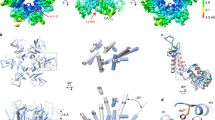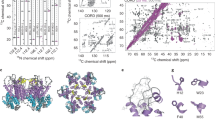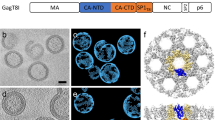Abstract
The type 1 human immunodeficiency virus (HIV-1) contains a conical capsid comprising ∼1,500 CA protein subunits, which organizes the viral RNA genome for uncoating and replication in a new host cell. In vitro, CA spontaneously assembles into helical tubes and cones that resemble authentic viral capsids1,2,3,4,5,6,7. Here we describe electron cryo-microscopy and image reconstructions of CA tubes from six different helical families. In spite of their polymorphism, all tubes are composed of hexameric rings of CA arranged with approximate local p6 lattice symmetry. Crystal structures of the two CA domains were ‘docked’ into the reconstructed density, which showed that the amino-terminal domains form the hexameric rings and the carboxy-terminal dimerization domains connect each ring to six neighbours. We propose a molecular model for the HIV-1 capsid that follows the principles of a fullerene cone6, in which the body of the cone is composed of curved hexagonal arrays of CA rings and the ends are closed by inclusion of 12 pentagonal ‘defects’.
This is a preview of subscription content, access via your institution
Access options
Subscribe to this journal
Receive 51 print issues and online access
$199.00 per year
only $3.90 per issue
Buy this article
- Purchase on Springer Link
- Instant access to full article PDF
Prices may be subject to local taxes which are calculated during checkout



Similar content being viewed by others
References
Ehrlich, L. S., Agresta, B. E. & Carter, C. A. Assembly of recombinant human immunodeficiency virus type 1 capsid protein in vitro. J. Virol. 66 , 4874–4883 (1992).
Campbell, S. & Vogt, V. M. Self-assembly in vitro of purified CA-NC proteins from rous sarcoma virus and human immunodeficiency virus type 1. J. Virol. 69, 6487– 6497 (1995).
Groß, I., Hohenberg, H. & Kräusslich, H.-G. In vitro assembly properties of purified bacterially expressed capsid proteins of human immunodeficiency virus. Eur. J. Biochem. 249, 592–600 (1997).
von Schwedler, U. K. et al. Proteolytic refolding of the HIV-1 capsid protein amino-terminus facilitates viral core assembly. EMBO J. 17, 1555–1568 (1998).
Groß, I., Hohenberg, H., Huckhagel, C. & Kräusslich, H.-G. N-terminal extension of human immunodeficiency virus capsid protein converts the in vitro assembly phenotype from tubular to spherical particles. J. Virol. 72, 4798–4810 (1998).
Ganser, B. K., Li, S., Klishko, V. Y., Finch, J. T. & Sundquist, W. I. Assembly and analysis of conical models for the HIV-1 core. Science 283, 80–83 (1999).
Grattinger, M. et al. In vitro assembly properties of wild-type and cyclophilin-binding defective human immunodeficiency virus capsid proteins in the presence and absence of cyclophilin A. Virology 257, 247–60 (1999).
Fukui, T., Imura, S., Goto, T. & Nakai, M. Inner architecture of human and simian immunodeficiency viruses. Micro. Res. Tech. 25, 335–340 ( 1993).
Kotov, A., Zhou, J., Flicker, P. & Aiken, C. Association of nef with the human immunodeficiency virus type 1 core. J. Virol. 73, 8824–30 (1999).
Welker, R., Hohenberg, H., Tessmer, U., Huckhagel, C. & Kräusslich, H. G. Biochemical and structural analysis of isolated mature cores of human immunodeficiency virus type 1. J. Virol. 74, 1168–1177 (2000).
Dorfman, T., Bukovsky, A., Öhagen, Å., Höglund, S. & Göttlinger, H. G. Functional domains of the capsid protein of human immunodeficiency virus type 1. J. Virol. 68, 8180–8187 (1994).
Gitti, R. K. et al. Structure of the amino-terminal core domain of the HIV-1 capsid protein. Science 273, 231– 235 (1996).
Momany, C. et al. Crystal structure of dimeric HIV-1 capsid protein. Nature Struct. Biol. 3, 763–770 (1996).
Gamble, T. R. et al. Crystal structure of human cyclophilin A bound to the amino-terminal domain of HIV-1 capsid. Cell 87, 1285– 1294 (1996).
Berthet-Colominas, C. et al. Head-to-tail dimers and interdomain flexibility revealed by the crystal structure of HIV-1 capsid protein (p24) complexed with a monoclonal antibody Fab. EMBO J. 18, 1124– 1136 (1999).
Worthylake, D. K., Wang, H., Yoo, S., Sundquist, W. I. & Hill, C. P. Structures of the HIV-1 capsid protein dimerization domain at 2. 6Å resolution. Acta Crystallogr. D 55, 85–92 (1999).
Jin, Z., Jin, L., Peterson, D. L. & Lawson, C. L. Model for lentivirus capsid core assembly based on crystal dimers of EIAV p26. J. Mol. Biol. 286, 83–93 ( 1999).
Caspar, D. & Klug, A. Physical principles in the construction of regular viruses. Cold Spring Harb. Symp. Quant. Biol. 27, 1–24 (1962).
Katsura, I. Structure and inhierent properties of the bacteriophage lambda head shell. I. Polyheads produced by two defective mutants in the major head protein. J. Mol. Biol. 121, 71– 93 (1978).
Steven, A. C. & Trus, B. L. in Electron Microscopy of Proteins 5, Viral Structure 1–35 (Academic, London, 1986).
Cremers, A. M. F., Oostergetel, G. T., Schilstra, M. J. & Mellema, J. E. An electron microscopic investigation of the structure of alfalfa mosaic virus. J. Mol. Biol. 145, 545– 561 (1981).
Zhang, H., Dornadula, G., Alur, P., Laughlin, M. A. & Pomerantz, R. J. Amphipathic domains in the C terminus of the transmembrane protein (gp41) permeabilize HIV-1 virions: a molecular mechanism underlying natural endogenous reverse transcription. Proc. Natl Acad. USA 93, 12519–12524 ( 1996).
Groß, I. et al. A conformational switch controlling HIV-1 morphogenesis. EMBO J. 19, 103–113 ( 2000).
Franke, E. K. & Luban, J. Cyclophilin and Gag in HIV-1 replication and pathogenesis. Adv. Exp. Med. Biol. 374, 217–28 (1995).
Mammano, F., Öhagen, Å., Höglund, S. & Göttlinger, H. G. Role of the major homology region of HIV-1 in virion morphogenesis. J. Virol. 68, 4927–4936 (1994).
Aberham, C., Weber, S. & Phares, W. Spontaneous mutations in the human immunodeficiency virus type 1 gag gene that affect viral replication in the presence of cyclosporins. J. Virol. 70, 3536–3544 (1996).
Toyoshima, C. & Unwin, N. Three-dimensional structure of the acetylcholine receptor by cryoelectron microscopy and helical image reconstruction. J. Cell Biol. 111, 2623– 2635 (1990).
Crowther, R. A., Henderson, R. & Smith, J. M. MRC image processing programs. J. Struct. Res. 116, 9–16 ( 1996).
Jones, T. A., Zou, J., Y., Cowan, S. W. & Kjeldgaard, M. Improved methods for building protein models in electron density maps and location of errors in these models. Acta Crystallogr. A 47, 110–119 ( 1991).
Acknowledgements
We thank W. Clemons, B. Ganser, J. Smith, C. Villa and D. Worthylake for technical assistance; J. Berriman for help and advice with data collection; and M. Stowell and N. Unwin for guidance in the use of their image reconstruction software. We also thank N. Unwin and R. Henderson for critical reading of our manuscript; and H.-G. Kräusslich for communicating results before publication. This research was supported by the MRC (UK) and by the NIH (US).
Author information
Authors and Affiliations
Corresponding author
Supplementary information
Rights and permissions
About this article
Cite this article
Li, S., Hill, C., Sundquist, W. et al. Image reconstructions of helical assemblies of the HIV-1 CA protein. Nature 407, 409–413 (2000). https://doi.org/10.1038/35030177
Received:
Accepted:
Issue Date:
DOI: https://doi.org/10.1038/35030177
This article is cited by
-
Enrich and switch: IP6 and maturation of HIV-1 capsid
Nature Structural & Molecular Biology (2023)
-
DNA-origami-directed virus capsid polymorphism
Nature Nanotechnology (2023)
-
Multidisciplinary studies with mutated HIV-1 capsid proteins reveal structural mechanisms of lattice stabilization
Nature Communications (2023)
-
Rotten to the core: antivirals targeting the HIV-1 capsid core
Retrovirology (2021)
-
The HIV-1 capsid and reverse transcription
Retrovirology (2021)
Comments
By submitting a comment you agree to abide by our Terms and Community Guidelines. If you find something abusive or that does not comply with our terms or guidelines please flag it as inappropriate.



